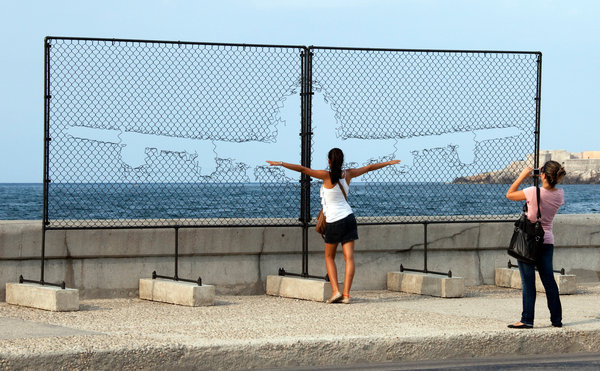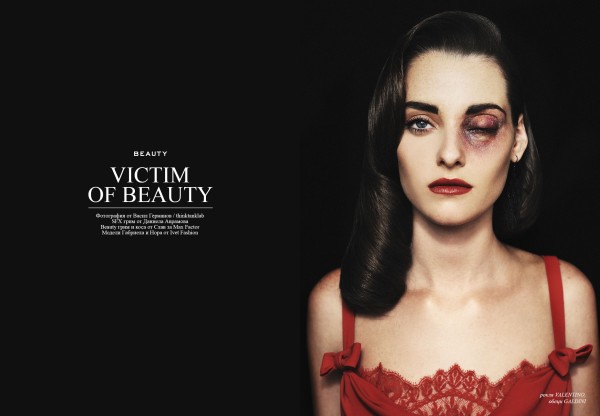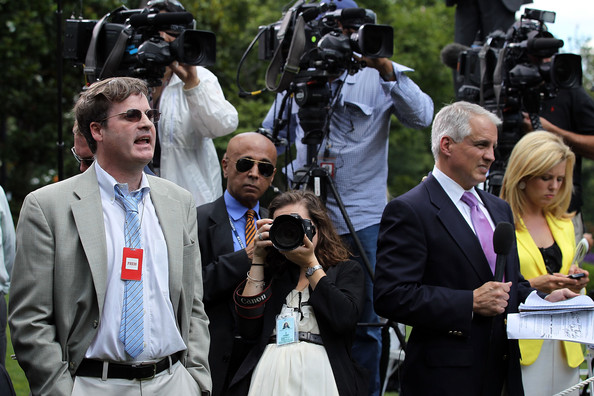Notes
Flying into the World Trade Center? Or, Just Photography's Fourth Wall?
I doubt that any title can quite capture the aesthetic intelligence contained in this photograph of an artwork by Arlés del Río at the 11th Havana Biennial.
I’ve referred to the fourth wall in order to highlight some of what the photographer has added to del Río’s remarkable installation. The wall refers to the formal barrier between stage and audience in the theater, and by extension between the artwork and audience in any work of fiction. The term is rarely applied to photography, which instead is assumed to either directly reproduce reality or immerse the spectator within visual experience. By contrast, this photograph clearly discriminates a series of viewer positions in regard to both the artwork and the photograph: the direct, embodied, even imitative response; the more distant act of recording the event with a camera; and the still more distant act of viewing the photograph. Each spectator is set out in a spatial array along the central axis–just off center right, back and further right, and then further back to center for your standpoint–and so you are oriented directly toward the art work but also zigzagging toward or away from it through these other viewers. Thus, a question arises: you can see what they are doing, so what are you doing?
But perhaps this is backwards, for I have described the photographer’s framing of the scene in place of its central object: del Río’s artwork. And what a work. The plane’s silhouette cuts through the screen with terrifying force–indeed, it is the presence of terror as it evokes the image of those planes hurtling into the twin towers on September 11, 2001. The poles at the center of the screen make that point emphatically, for they need not be there and so remind us that in place of an ethereal image real aircraft collided with buildings of steel and glass. Because this plane is but an outline and air, it becomes a ghostly sign of all that now is gone forever, from the planes to the buildings to the people within. In the artwork, however, the plane both hangs in the air and has already cut into the wall of the building. It is just at the other side of impact and already past that point, barreling past us in an invisible fireball. We see a provisional structure of concrete blocks and metal fencing, and an impossible compression of time and space, and a terrifying emptiness.
But is it really a 9/11 image? No one actually saw the outline of a plane cut into one of the towers–that image is entirely reconstructive. Likewise, the woman entraining her body with the outline is being playful, not mournfully commemorative. She seems to be channeling her inner child, as if running around the yard imagining that she’s a plane, although now also with something of the dancer’s body sense of weights, ratios, and coordinated movement that is available to an adult. She imagines not horror but the beauty of flight, and perhaps also its fantasies of adventure, liberation, or transcendence. By showing one viewer’s response, the photograph reminds us that meaning is characterized by plurality.
And what of the woman behind with the camera? Whatever her attitude, it is confounded by the much more prosaic act of taking the photograph. And is she trying to record the artwork or her friend’s imitation of it? (Thanks to cheap imaging technologies, tourists now regularly play this life-imitating-art game in museums, as when kids will act out a sculptural tableau for the camera.) Because either photographer could have taken a picture of the artwork alone, we have to assume that they are intending to foreground viewer responsiveness. But is the artwork just a pretext for a little play in the performance of everyday life, or are art and audience being brought into view in order to question what they have in common?
And what about you? The photograph clearly creates a space for the viewer: that is, it points backwards toward the space inhabited by the viewer. In fact, each of the positions becomes calibrated as what we might call degrees of separation: the artwork from the reality it represents, followed by the direct response, followed by the documentary response, followed by the mediated response. What is more important, however, is how the image can simultaneously mark and collapse those distances. Photography has a fourth wall, but like del Rio’s artwork, it also can remind us that the task of art is not to reproduce the direct encounter. Photography works by making things present, but also by evoking what is absent; by bringing things closer, but also by maintaining the distance needed for reflection.
— Robert Hariman
(cross-posted from No Caption Needed)
(photo: Jose Goitia for The New York Times. The artwork by Arlés del Río is entitled “Fly Away.”)



Reactions
Comments Powered by Disqus